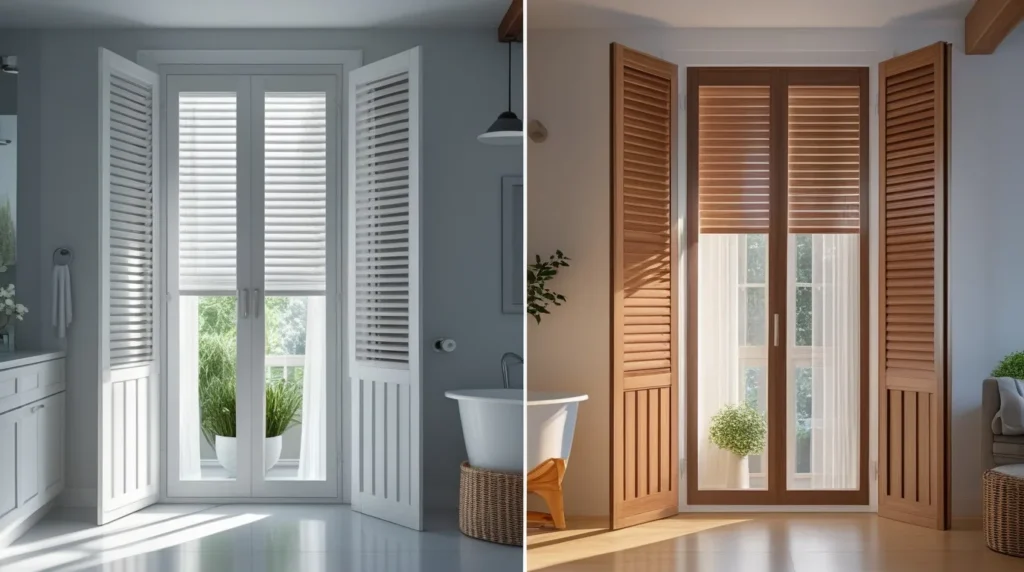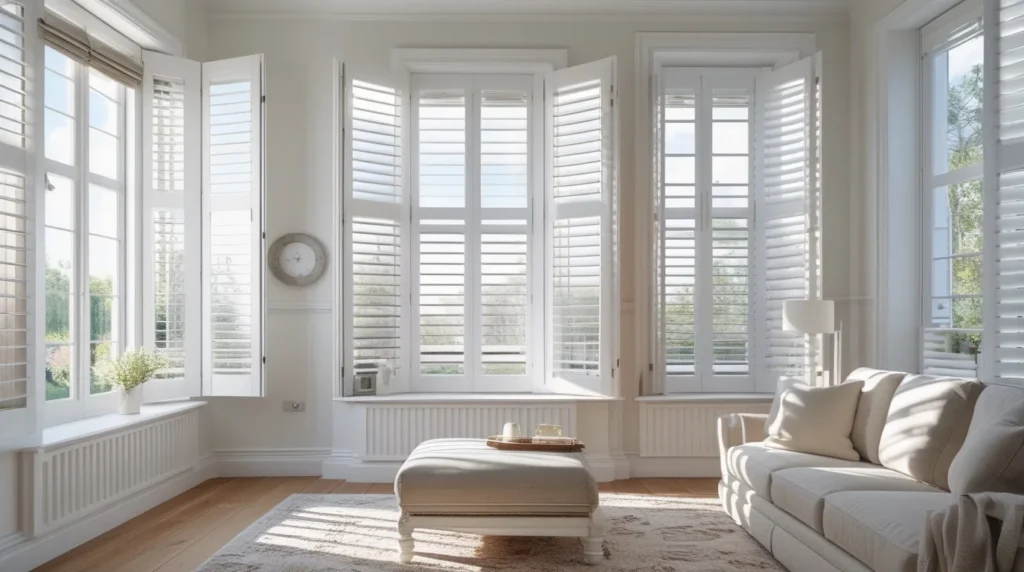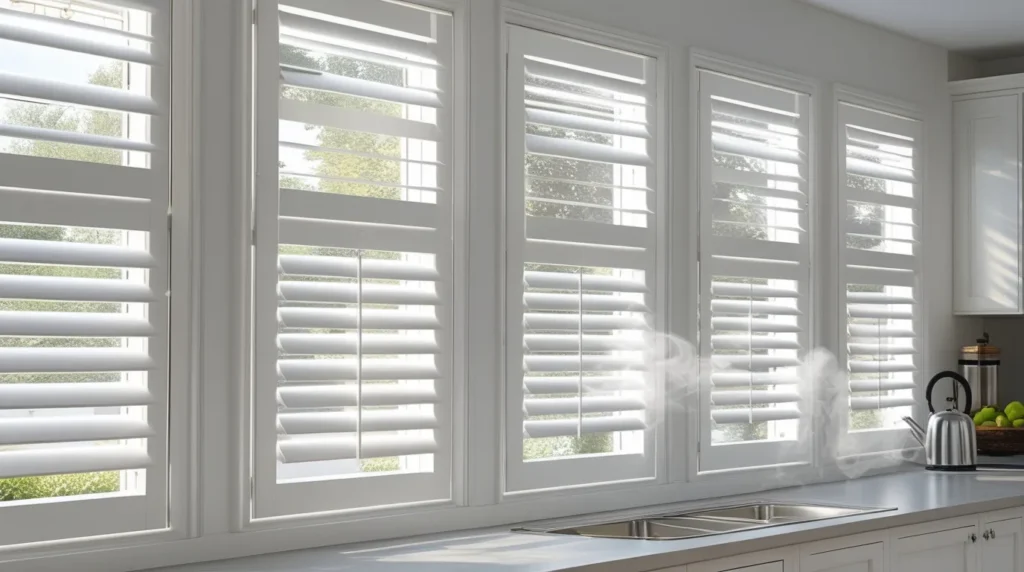composite shutters vs wood shutters, so which one? Choosing the right window treatment can be tricky, especially when deciding between composite shutters vs wood shutters. Both offer great benefits, but they are different in looks, cost, and care. This guide will help you understand how they work, what they look like, and which one may be the better pick for your home. At Blinds Crafter, we believe informed choices lead to better living spaces. Whether you’re planning a full window makeover or just one room, this guide will help you choose smartly and easily.
What Are Interior Shutters and Why Do They Matter in Home Design?
Interior shutters are panels with slats that cover your windows. They help block out sunlight, give privacy, and make your home look nicer. People love them because they fit many styles, from modern to traditional. Shutters also add value to your home. They’re not just window coverings—they become part of the room. Whether you pick wood or composite, shutters are strong and last a long time. Some even help with keeping rooms cooler or warmer, depending on the season. That means comfort and savings in the long run.
Exploring the Most Common Shutter Materials for Residential Spaces
There are three main types of shutters: wood, composite, and vinyl. Wood shutters are classic and strong. They look natural and feel warm. Composite shutters are made from wood mixed with plastic. They look like wood but are tougher in damp rooms. Vinyl shutters are the cheapest. They don’t look as nice but are water-resistant. Each material has good points. The right one depends on where you’ll use it and how much you want to spend. It’s all about finding the right mix of beauty and use.
Wood Shutters: Timeless Style with Natural Strength
Wood shutters are made from real wood, like basswood or poplar. They’re strong and can be painted or stained. Many people love them because they have a natural charm. They feel solid and work well in dry rooms like living rooms or bedrooms. Wood shutters also fit any design—from farmhouse to formal. But they need care. Wood can warp in wet places. It also needs cleaning to stay nice. Still, if you want a classic look, wood shutters are a smart choice that never goes out of style.
Composite Shutters: A Practical Twist on a Classic Look
Composite shutters offer a compelling alternative in the composite shutters vs wood shutters debate. Crafted from a blend of real wood and synthetic materials, they are engineered for exceptional strength and stability. Unlike real wood, they are highly resistant to warping and cracking in moist environments, making them an ideal choice for high-humidity areas like kitchens and bathrooms.
While they beautifully mimic the authentic look of wood, composite shutters require significantly less maintenance. There’s no need for frequent painting or polishing. They also come in a wide variety of styles and colors to match any décor. For those seeking a stylish, durable, and easy-to-manage window treatment, composite shutters are a smart option. They provide the classic appeal of wood often at a more accessible price point, making them a fantastic value in the world of window coverings.
Composite Shutters vs Wood Shutters: Which One Should You Choose?
Here’s a simple breakdown to help you compare:
- Look & Feel: Wood shutters have a natural grain and warmth; composite shutters mimic wood but are more uniform.
- Maintenance: Wood needs regular cleaning and protection; composite is low-maintenance and easy to clean.
- Durability: Wood may warp in moisture; composite is moisture-resistant and better for kitchens or bathrooms.
- Cost: Wood tends to be more expensive; composite is a more budget-friendly choice.
- Best Use: Use wood in dry, formal spaces; composite works well in high-humidity areas.
Pick what suits your home’s needs, style, and how much care you’re willing to give.
Pros and Cons of Wood vs Composite Plantation Shutters
Plantation shutters have wide slats and a clean look. They work great in many homes. With wood vs composite plantation shutters, both look good, but the feel is different. Pros of wood: natural texture, custom paint or stain, adds value. Cons of wood: warps in wet areas, needs regular care. Pros of composite: tough against moisture, easy to clean, looks like wood. Cons of composite: fewer color options, less custom shaping. Pick wood if style comes first. Go with composite if you want easy care and toughness.
Wood Shutters vs Composite Shutters: Comparing Long-Term Value
Think about the future:
- Lifespan: Wood shutters can last for decades with proper care.
- Upkeep: Composite shutters need less maintenance, saving time and effort.
- Weather Resistance: Composite handles heat, cold, and moisture better.
- Style Longevity: Wood offers timeless beauty that suits traditional and modern homes.
- Property Value: Both can add value, but wood may boost resale appeal slightly more.
Choose based on how much work you want to do and how long you plan to stay in your home.
Composite Shutters vs Vinyl: Know the Differences Before You Buy

Some people mix up composite shutters vs vinyl, but they’re not the same. Vinyl shutters are 100% plastic. They’re good for wet spaces and cost the least. But they can feel flimsy and look cheap. Composite shutters are thicker and stronger. They have a wood core or fiber mix, making them last longer. They also look more like real wood. So if style and strength matter, choose composite. Vinyl may work in a laundry room, but for most rooms, composite is the better bet. It’s a step up without going all the way to wood.
What Do Homeowners in Saddle River, NJ Prefer for Their Windows?
In Saddle River, NJ, many homeowners want shutters that look good and handle all four seasons. Humid summers and snowy winters make composite shutters a top pick. They don’t warp and are easy to clean. Still, some homes with classic styles use wood for that rich, warm look. It really depends on the room and personal taste. Blinds Crafter has helped many local homeowners find what works best. Whether it’s the strength of composite or the charm of wood, we help you match your shutters to your life and space.
How to Match Shutter Type with Room Needs and Climate
When choosing between composite shutters vs wood shutters, first consider their location. For moisture-prone areas like bathrooms or kitchens, composite shutters are ideal as they resist swelling. In drier spaces like bedrooms or dining rooms, wood shutters add classic warmth and elegance.
Also, think about light and climate. For sunny spots that need strong light blocking and heat resistance, composite shutters perform excellently. In colder rooms, both types can help with insulation. Ultimately, the right choice in the composite shutters vs wood shutters debate depends on your room’s climate, your lifestyle, and your practical needs—not just looks.
Final Thoughts: Make a Confident Choice That Fits Your Home Best
Both wood and composite shutters have real benefits. Composite shutters vs wood shutters isn’t about right or wrong—it’s about what works for you. Want low care and moisture resistance? Go with composite. Want classic style and custom design? Wood is the way. The best choice matches your home’s needs and your personal style. At Blinds Crafter, we’re here to help you explore both options with no pressure. We make it simple to find the shutters that will look great and last long.
Ready to upgrade your windows with a look that lasts? Reach out today and let us help you bring comfort and style into every room.



